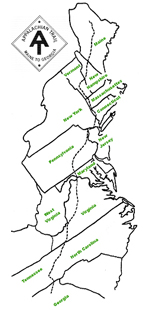|
Sept
14 , 1983 Wednesday (82.1 mtg) From
Gonzo!s Appalachian Trail journal
Since
last night, I was curious just how far I was from what was named
Sydney Tappan Campsite. I wondered whether Rich and I had camped
at the site last night, or if we had not yet reached it. I had a
feeling that it was still to come. I left this morning with that
question in my mind, and within a couple of miles, I got my answer.
I passed through the campsite, which was no more than a clearing
among the small trees that surrounded the area. I had spent the
night last night at the crossing of the Gulf Hagas Brook, just before
the climb up Gulf Hagas Mountain. As small as the trees were in
the area of Sydney Tappan Campsite, I wondered if there had been
a fire, or a clear cut done in the area recently. The blazing was
poor, and made particularly worse by the fact that there were many
"trails" leading here and there through the brush. I followed
the one that began to climb and sure enough that was the correct
one. I ascended West Peak, and then Hay Mountain, each taking up
roughly one mile each. During the ascent, I found small, dwarfed
blossoms on bunch berry plants growing along the trail which I found
interesting this late in the season.
Somewhere in the area after Sydney Tapan campsite, I passed Butch
and Rob, and then they caught up with me as I read the register
and signed in at the registration box located in the saddle, or
notch if you prefer, before climbing White Cap. Soon I was on
my way up the last big mountain before Katahdin: White Cap Mountain,
with an elevation of just below 3500 feet. There would be nothing
over 2000 feet until Katahdin.
White Cap summit was gained via a steep rocky path similar to those
in the Whites, and culminated with a spectacular view of the surrounding
area. I could see back to the Barren Chairback Range. We passed
to the other side of the microwave and radar installation and was
astounded to see our first verifiable view of Katahdin, the last
mountain on the trail, still 74 miles by trail! What a majestic
mountain standing solitary among the plains of the north woods -
the remains of a mountain that when it was young, was probably taller
than Mount Everest. Lakes and "flat territory" lie below
in the area between. I began to feel as though the trip was almost
over. Elated that I had been fortunate enough to have come this
far, yet sad that the end was near, I began the descent on a freshly
cut trail of soft organic material that cushioned my footsteps,
yet hid the tree roots ready to trip you if you were not careful.
One mile past the summit, I stopped at the new Logan Brook Lean-to
for lunch. I caught up with Butch and Rob there once again. The
shelter was only weeks old and was therefore in excellent shape
except for the "lawn" out front. The entire ground had
no vegetation and was one big mud slick. A nice stream rushed from
the upper reaches of White Cap Mountain past the shelter just a
few yards from the lean-to opening. I filled up my bottles with
the ice cold, refreshing liquid. I found a piece of a moose antler
that someone had left at the shelter. Not a large piece, but recognizable
as a moose rather than a deer. There were telltale indications that
the rest had been eaten by rodents. Little grooves cut by sharp
teeth reminded me of all the nights that I had been awakened by
the sound of mice gnawing on something that I hoped was not mine.
On
the way down the mountain I ran into a couple of local fishermen
on their way to their secret fishing hole to catch some lunker trout.
We talked for a while and I gleened some information about an upcoming
shelter from them. They told me a story about how some hikers had
found it accidentally when taking a different route than the AT.
I figured it must have been the old AT they were following. I recorded
the information for later use if needed.
Four miles later after reaching the "lowlands," I found
the East Branch of the Pleasant River. The ford was not particularly
difficult, but the scenery in the area took my breath away! Wilderness
at its finest was the feeling that came over me as I snapped a picture.
Somewhere on the way up Little Boardman Mountain I came across some
vacationers from Illinois who thought that they had reached the
summit. I told them that I did not think so, and within a few hundred
yards I saw a sign indicating a side trail to the summit with views
of Katahdin. I did not stop to look. The trail descended toward
a body of water below. I skirted the edge of Crawford Pond and then
crossed a bridge that appeared to be just a log-jamb of fallen timber
at the outlet of the pond. From there the trail followed Cooper
Brook, the flow leaving Crawford Pond, for two miles over easy grade
mostly through Birch forest on the way to Cooper Brook Lean-to located
just beside the Brook. This was some of the easiest and most relaxing
walking that I had done on the entire journey. Almost like following
an old railroad bed.
At the shelter I met Ed
Powers, who had been ahead of me in the registers for the entire
trip. At this point he had begun to slow down and was going to spend
a night in each one of the shelters located in the 100 mile wilderness.
The shelter was another one of those irregular floored baseball
bat shelters, but the setting made up for it. Cooper Brook Falls
could be seen and heard just outside the shelter, and the baseball
bat platform even added to the wilderness feel. A nice pool of water
containing bubbles produced by the falls swirled about playfully
directly in front of the shelter. Cooper Brook Lean-to remains near
the top of my list of places to stay along the Appalachian Trail.
I drifted off to a peaceful sleep aided by the sounds of water rushing
over the falls, a sound that I realized was virtually the same as
rain, or sometimes wind blowing through the trees. In a way, I would
miss those sounds soon.
Gonzo!
Appalachian Trail Journals ©1983
|



